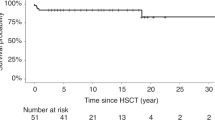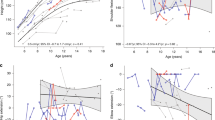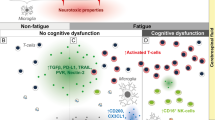Abstract
In metachromatic leukodystrophy (MLD), the deficiency of the lysosomal enzyme arylsulfatase A (ARSA) leads to demyelination in the central and peripheral nervous system and ultimately to death. Allogeneic hematopoietic SCT (HSCT) is currently the only treatment for adult and late-onset juvenile MLD, although it is still in question because of insufficient follow-up. We wanted to determine whether HSCT could halt the progression of adult and late-onset juvenile MLD. Four treated unrelated patients and three untreated siblings were included in the study, and followed regularly for up to 18 years after transplantation. The patients were assessed from clinical examination, ARSA enzyme levels, magnetic resonance imaging of the brain and neuropsychological and neurophysiological tests. In the treated patients, ARSA levels were normal up to 18 years after transplantation. The parameters evaluated stabilized and remained stable after a latency period of 12–24 months. Two patients live normal lives, partially in a protected environment. The other two patients stabilized at a low cognitive and functional level. One of the controls is demented, one is in a vegetative state and one died. We conclude that, in comparison with their untreated siblings, HSCT halted the progression of the disease in our treated patients.
This is a preview of subscription content, access via your institution
Access options
Subscribe to this journal
Receive 12 print issues and online access
$259.00 per year
only $21.58 per issue
Buy this article
- Purchase on Springer Link
- Instant access to full article PDF
Prices may be subject to local taxes which are calculated during checkout



Similar content being viewed by others
References
von Figura K, Gieselmann V, Jaeken J Metachromatic leukodystrophy. In: Scriver CR, Beaudet AL (eds). The Metabolic & Molecular Bases of Inherited Disease 8th edn. McGraw-Hill: New York, NY, USA, 2001. pp 3695–3724.
Shapiro EG, Lockman LA, Knopman D, Krivit W Characteristics of the dementia in late-onset metachromatic leukodystrophy. Neurology 1994; 44: 662–665.
Finelli PF Metachromatic leukodystrophy manifesting as a schizophrenic disorder: computed tomographic correlation. Ann Neurol 1985; 18: 94–95.
Hageman AT, Gabreëls FJ, de Jong JG, Gabreëls-Festen AA, van den Berg CJ, van Oost BA et al. Clinical symptoms of adult metachromatic leukodystrophy and arylsulfatase A pseudodeficiency. Arch Neurol 1995; 52: 408–413.
Krall WJ, Challita PM, Perlmutter LS, Skelton DC, Kohn DB Cells expressing human glucocerebrosidase from a retroviral vector repopulate macrophages and central nervous system microglia after murine bone marrow transplantation. Blood 1994; 83: 2737–2748.
Navarro C, Fernández JM, Domínguez C, Fachal C, Alvarez M Late juvenile metachromatic leukodystrophy treated with bone marrow transplantation; a 4-year follow-up study. Neurology 1996; 46: 254–256.
Görg M, Wilck W, Granitzny B, Suerken A, Lukacs Z, Ding X et al. Stabilization of juvenile metachromatic leukodystrophy after bone marrow transplantation: a 13-year follow-up. J Child Neurol 2007; 22: 1139–1142.
Meuleman N, Vanhaelen G, Tondreau T, Lewalle P, Kwan J, Bennani J et al. Reduced intensity conditioning haematopoietic stem cell transplantation with mesenchymal stromal cells infusion for the treatment of metachromatic leukodystrophy: a case report. Haematologica 2008; 93: e11–e13.
Krägeloh-Mann I, Groeschel S, Kehrer C, Opherk K, Nägele T, Handgretinger R et al. Juvenile metachromatic leukodystrophy 10 years post transplant compared with a non-transplanted cohort. Bone Marrow Transplant 2013; 48: 369–375.
Ding XQ, Bley A, Kohlschütter A, Fiehler J, Lanfermann H . Long-term neuroimaging follow-up on an asymptomatic juvenile metachromatic leukodystrophy patient after hematopoietic stem cell transplantation: evidence of myelin recovery and ongoing brain maturation. Am J Med Genet A 2012; 158A: 257–260.
deHosson LD, van de Warrenburg BP, Preijers FW, Blijlevens NM, van der Reijden BA, Kremer HP et al. Adult metachromatic leukodystrophy treated by allo-SCT and a review of the literature. Bone Marrow Transplant 2011; 46: 1071–1076.
Solders G, Celsing G, Hagenfeldt L, Ljungman P, Isberg B, Ringdén O Improved peripheral nerve conduction, EEG and verbal IQ after bone marrow transplantation for adult metachromatic leukodystrophy. Bone Marrow Transplant 1998; 22: 1119–1122.
Biffi A, Lucchini G, Rovelli A, Sessa M Metachromatic leukodystrophy: an overview of current and prospective treatments. Bone Marrow Transplant 2008; 42 (Suppl 2): S2–S6.
Schaffer M, Aldener-Cannavá A, Remberger M, Ringdén O, Olerup O Roles of HLA-B, HLA-C and HLA-DPA1 incompatibilities in the outcome of unrelated stem-cell transplantation. Tissue Antigens 2003; 62: 243–250.
Ringdén O, Remberger M, Svahn BM, Barkholt L, Mattsson J, Aschan J et al. Allogeneic hematopoietic stem cell transplantation for inherited disorders: experience in a single center. Transplantation 2006; 81: 718–725.
Storb R, Deeg HJ, Whitehead J, Appelbaum F, Beatty P, Bensinger W et al. Methotrexate and cyclosporine compared with cyclosporine alone for prophylaxis of acute graft versus host disease after marrow transplantation for leukemia. N Engl J Med 1986; 314: 729–735.
Svahn BM, Remberger M, Myrbäck KE, Holmberg K, Eriksson B, Hentschke P et al. Home care during the pancytopenic phase after allogeneic hematopoietic stem cell transplantation is advantageous compared with hospital care. Blood 2002; 100: 4317–4324.
Solders G, Andersson T, Borin Y, Brandt L, Persson A Electroneurography index: a standardized neurophysiological method to assess peripheral nerve function in patients with polyneuropathy. Muscle Nerve 1993; 16: 941–946.
Eichler F, Grodd W, Grant E, Sessa M, Biffi A, Bley A et al. Metachromatic leukodystrophy: a scoring system for brain MR imaging observations. AJNR Am J Neuroradiol 2009; 30: 1893–1897.
Shapiro EG, Lockman LA, Balthazor M, Krivit W Neuropsychological outcomes of several storage diseases with and without bone marrow transplantation. J Inherit Metab Dis 1995; 18: 413–429.
Guffon N, Souillet G, Maire I, Dorche C, Mathieu M, Guibaud P Juvenile metachromatic leukodystrophy: neurological outcome two years after bone marrow transplantation. J Inherit Metab Dis 1995; 18: 159–161.
Frassoni F, Labopin M, Powles R, Mary JY, Arcese W, Bacigalupo A et al. Effect of centre on outcome of bone-marrow transplantation for acute myeloid leukaemia. Acute Leukaemia Working Party of the European Group for Blood and Marrow Transplantation. Lancet 2000; 355: 1393–1398.
Oh H, Loberiza FR, Zhang MJ, Ringdén O, Akiyama H, Asai T et al. Comparison of graft-versus-host-disease and survival after HLA-identical sibling bone marrow transplantation in ethnic populations. Blood 2005; 105: 1408–1416.
Clarke JT, Skomorowski MA, Chang PL Marked clinical difference between two sibs affected with juvenile metachromatic leukodystrophy. Am J Med Genet 1989; 33: 10–13.
Peters C, Steward CG Hematopoietic cell transplantation for inherited metabolic diseases: an overview of outcomes and practice guidelines. Bone Marrow Transplant 2003; 31: 229–239.
Kapaun P, Dittmann RW, Granitzny B, Eickhoff W, Wulbrand H, Neumaier-Probst E et al. Slow progression of juvenile metachromatic leukodystrophy 6 years after bone marrow transplantation. J Child Neurol 1999; 14: 222–228.
Ringdén O, Groth CG, Erikson A, Granqvist S, Månsson JE, Sparrelid E Ten years' experience of bone marrow transplantation for Gaucher disease. Transplantation 1995; 59: 864–870.
Cable C, Finkel RS, Lehky TJ, Biassou NM, Wiggs EA, Bunin N et al. Unrelated umbilical cord blood transplant for juvenile metachromatic leukodystrophy: a 5-year follow-up in three affected siblings. Mol Genet Metab 2011; 102: 207–209.
Author information
Authors and Affiliations
Corresponding author
Ethics declarations
Competing interests
The authors declare no conflict of interest.
Rights and permissions
About this article
Cite this article
Solders, M., Martin, D., Andersson, C. et al. Hematopoietic SCT: a useful treatment for late metachromatic leukodystrophy. Bone Marrow Transplant 49, 1046–1051 (2014). https://doi.org/10.1038/bmt.2014.93
Received:
Revised:
Accepted:
Published:
Issue Date:
DOI: https://doi.org/10.1038/bmt.2014.93
This article is cited by
-
Early clinical course after hematopoietic stem cell transplantation in children with juvenile metachromatic leukodystrophy
Molecular and Cellular Pediatrics (2020)
-
Current Perspective of Stem Cell Therapy in Neurodegenerative and Metabolic Diseases
Molecular Neurobiology (2017)
-
Cerebral Spinal Fluid levels of Cytokines are elevated in Patients with Metachromatic Leukodystrophy
Scientific Reports (2016)
-
Long-term outcomes after allogeneic hematopoietic stem cell transplantation for metachromatic leukodystrophy: the largest single-institution cohort report
Orphanet Journal of Rare Diseases (2015)
-
In Vivo NMR Studies of the Brain with Hereditary or Acquired Metabolic Disorders
Neurochemical Research (2015)



